Fuzzy Evaluation of Crowd Safety Based on Pedestrians’ Number and Distribution Entropy
Abstract
1. Introduction
2. Related Work
2.1. Crowd Behavior Models
2.2. Crowd Status Detection
3. Calculation of the Pedestrian’s Number Attribute
3.1. Foreground Pixel Extraction
3.2. Pixel Interpolation
3.3. Pedestrian’s Number Regression
4. Describing Crowd Uniformity Using Distribution Entropy
4.1. Regional Division of Crowd Movement
4.2. Calculation of Crowd Distribution Entropy
5. Fuzzy Inference and Evaluation of Crowd Safety Status
5.1. Fuzzification
5.1.1. Fuzziness of Pedestrians’ Number
5.1.2. Fuzziness of Entropy of Crowd Distribution
5.1.3. Fuzziness of Crowd Safety Status
5.2. Fuzzy Inference
5.3. Defuzzification
6. Experiment and Discussion
6.1. Experimental Results of Safety Status Evaluation
6.2. Global Performance Analysis using MAE and MRE
7. Conclusions
Author Contributions
Funding
Conflicts of Interest
References
- Dong, Z.; Zhang, R.; Shao, X.; Li, Y. Scale-Recursive Network with point supervision for crowd scene analysis. Neurocomputing 2020, 384, 314–324. [Google Scholar] [CrossRef]
- Zhong, J.; Cai, W.; Lees, M.; Luo, L. Automatic model construction for the behavior of human crowds. Appl. Soft Comput. 2017, 56, 368–378. [Google Scholar] [CrossRef]
- Li, J.; Wang, L.; Tang, S.; Zhang, B.; Zhang, Y. Risk-based crowd massing early warning approach for public places: A case study in China. Saf. Sci. 2016, 89, 114–128. [Google Scholar] [CrossRef]
- Wang, J.; Jin, B.; Li, J.; Chen, F.; Wang, Z.; Sun, J. Method for guiding crowd evacuation at exit: The buffer zone. Saf. Sci. 2019, 118, 88–95. [Google Scholar] [CrossRef]
- Chen, X.-H.; Lai, J.-H. Detecting abnormal crowd behaviors based on the div-curl characteristics of flow fields. Pattern Recognit. 2019, 88, 342–355. [Google Scholar] [CrossRef]
- Behera, S.; Dogra, D.P.; Bandyopadhyay, M.K.; Roy, P.P. Estimation of linear motion in dense crowd videos using Langevin model. Expert Syst. Appl. 2020, 150, 113333. [Google Scholar] [CrossRef]
- Ma, Y.; Li, L.; Zhang, H.; Chen, T. Experimental study on small group behavior and crowd dynamics in a tall office building evacuation. Phys. A Stat. Mech. Appl. 2017, 473, 488–500. [Google Scholar] [CrossRef]
- Shiwakoti, N.; Gong, Y.; Shi, X.; Ye, Z. Examining influence of merging architectural features on pedestrian crowd movement. Saf. Sci. 2015, 75, 15–22. [Google Scholar] [CrossRef]
- Karamouzas, I.; Overmars, M. Simulating and Evaluating the Local Behavior of Small Pedestrian Groups. IEEE Trans. Vis. Comput. Graph. 2011, 18, 394–406. [Google Scholar] [CrossRef]
- Xu, M.; Wu, Y.; Lv, P.; Jiang, H.; Luo, M.; Ye, Y. miSFM: On combination of Mutual Information and Social Force Model towards simulating crowd evacuation. Neurocomputing 2015, 168, 529–537. [Google Scholar] [CrossRef]
- Zhang, X.; Yu, Q.; Yu, H. Physics Inspired Methods for Crowd Video Surveillance and Analysis: A Survey. IEEE Access 2018, 6, 66816–66830. [Google Scholar] [CrossRef]
- Cong, Y.; Yuan, J.; Liu, J. Abnormal event detection in crowded scenes using sparse representation. Pattern Recognit. 2013, 46, 1851–1864. [Google Scholar] [CrossRef]
- Jin, Z.; Bhanu, B. Analysis-by-synthesis: Pedestrian tracking with crowd simulation models in a multi-camera video network. Comput. Vis. Image Underst. 2015, 134, 48–63. [Google Scholar] [CrossRef]
- Fradi, H.; Eiselein, V.; Dugelay, J.-L.; Keller, I.; Sikora, T. Spatio-temporal crowd density model in a human detection and tracking framework. Signal. Process. Image Commun. 2015, 31, 100–111. [Google Scholar] [CrossRef]
- Zhang, Y.; Chang, F.; Wang, M.; Zhang, F.; Han, C. Auxiliary learning for crowd counting via count-net. Neurocomputing 2018, 273, 190–198. [Google Scholar] [CrossRef]
- Fradi, H.; Dugelay, J.-L. Towards crowd density-aware video surveillance applications. Inf. Fusion 2015, 24, 3–15. [Google Scholar] [CrossRef]
- Yuan, Y.; Feng, Y.; Lu, X. Statistical Hypothesis Detector for Abnormal Event Detection in Crowded Scenes. IEEE Trans. Cybern. 2017, 47, 3597–3608. [Google Scholar] [CrossRef]
- Zhang, X.; Shu, X.; He, Z. Crowd panic state detection using entropy of the distribution of enthalpy. Phys. A Stat. Mech. Appl. 2019, 525, 935–945. [Google Scholar] [CrossRef]
- Saleh, S.A.M.; Suandi, S.A.; Ibrahim, H. Recent survey on crowd density estimation and counting for visual surveillance. Eng. Appl. Artif. Intell. 2015, 41, 103–114. [Google Scholar] [CrossRef]
- Fu, M.; Xu, P.; Li, X.; Liu, Q.; Ye, M.; Zhu, C. Fast crowd density estimation with convolutional neural networks. Eng. Appl. Artif. Intell. 2015, 43, 81–88. [Google Scholar] [CrossRef]
- Shannon, C.E. A mathematical theory of communication. Bell Syst. Tech. 1948, 27, 379–423. [Google Scholar] [CrossRef]
- Shannon, C.E.; Wyner, S.A. (Eds.) Collected Papers; IEEE Press: New York, NY, USA, 1993. [Google Scholar]
- Tribus, M.; McIrvine, E.C. Energy and information. Sci. Am. 1971, 225, 179–188. [Google Scholar] [CrossRef]
- Wan, J.; Guo, N. Shannon Entropy in Configuration Space for Ni-Like Isoelectronic Sequence. Entropy 2019, 22, 33. [Google Scholar] [CrossRef]
- Nicolis, O.; Mateu, J.; Contreras-Reyes, J.E. Wavelet-Based Entropy Measures to Characterize Two-Dimensional Fractional Brownian Fields. Entropy 2020, 22, 196. [Google Scholar] [CrossRef]
- Farhan, A.K.; Al-Saidi, N.M.G.; Maolood, A.T.; Nazarimehr, F.; Hussain, I. Entropy Analysis and Image Encryption Application Based on a New Chaotic System Crossing a Cylinder. Entropy 2019, 21, 958. [Google Scholar] [CrossRef]
- Zadeh, L.A. Fuzzy sets. Inf. Control 1965, 8, 338–353. [Google Scholar] [CrossRef]
- Mamdani Application of Fuzzy Logic to Approximate Reasoning Using Linguistic Synthesis. IEEE Trans. Comput. 1977, 26, 1182–1191. [CrossRef]
- Wang, W.; Tong, S. Observer-Based Adaptive Fuzzy Containment Control for Multiple Uncertain Nonlinear Systems. IEEE Trans. Fuzzy Syst. 2019, 27, 2079–2089. [Google Scholar] [CrossRef]
- Feng, S.; Chen, C.L.P. Fuzzy Broad Learning System: A Novel Neuro-Fuzzy Model for Regression and Classification. IEEE Trans. Cybern. 2020, 50, 414–424. [Google Scholar] [CrossRef]
- Mintz, A. Non-adaptive group behavior. J. Abnorm. Soc. Psychol. 1951, 46, 150–159. [Google Scholar] [CrossRef]
- Kelley, H.H.; Condry, J.C.; Dahlke, A.E.; Hill, A.H. Collective behavior in a simulated panic situation. J. Exp. Soc. Psychol. 1965, 1, 20–54. [Google Scholar] [CrossRef]
- Helbing, D.; Molnár, P. Social force model for pedestrian dynamics. Phys. Rev. E 1995, 51, 4282–4286. [Google Scholar] [CrossRef] [PubMed]
- Helbing, D.; Farkas, I.; Molnar, P.; Vicsek, T. Simulation of Pedestrian Crowds in Normal and Evacuation Situations. Pedestr. Evacuation Dyn. 2002, 21, 21–58. [Google Scholar]
- Helbing, D.; Farkas, I.J.; Vicsek, T. Simulating dynamical features of escape panic. Nature 2000, 407, 487–490. [Google Scholar] [CrossRef] [PubMed]
- Farrahi, K.; Zia, K.; Sharpanskykh, A.; Ferscha, A.; Muchnik, L. Agent Perception Modeling for Movement in Crowds. In Proceedings of the 11th International Conference on Practical Applications of Agents and Multi-Agent Systems (PAAMS), Germany, 22–24 May 2013; Springer: Berlin/Heidelberg, Germany, 2013. [Google Scholar]
- Golas, A.; Narain, R.; Lin, M.C. Continuum modeling of crowd turbulence. Phys. Rev. E 2014, 90. [Google Scholar] [CrossRef]
- Golas, A.; Narain, R.; Curtis, S.; Lin, M.C. Hybrid Long-Range Collision Avoidance for Crowd Simulation. IEEE Trans. Vis. Comput. Graph. 2013, 20, 1022–1034. [Google Scholar] [CrossRef]
- Stephen, J.G.; Kim, S.; Lin, M.; Manocha, D. Simulating heterogeneous crowd behaviors using personality trait theory. In Proceedings of the 2011 ACM SIGGRAPH/Eurographics Symposium on Computer Animation, Vancouver, BC, Canada, 5–7 August 2011. [Google Scholar]
- Akopov, A.S.; Beklaryan, L.A. An agent model of crowd behavior in emergencies. Autom. Remote. Control 2015, 76, 1817–1827. [Google Scholar] [CrossRef]
- Gu, X.; Cui, J.; Zhu, Q. Abnormal crowd behavior detection by using the particle entropy. Optik 2014, 125, 3428–3433. [Google Scholar] [CrossRef]
- Zhao, K.; Liu, B.; Li, W.; Yu, N.; Liu, Z. Anomaly Detection and Localization: A Novel Two-Phase Framework Based on Trajectory-Level Characteristics. In Proceedings of the 2018 IEEE International Conference on Multimedia & Expo. Workshops (ICMEW), San Diego, CA, USA, 23–27 July 2018. [Google Scholar]
- Hao, Y.; Xu, Z.; Liu, Y.; Wang, J.; Fan, J.-L. Effective Crowd Anomaly Detection Through Spatio-temporal Texture Analysis. Int. J. Autom. Comput. 2018, 16, 27–39. [Google Scholar] [CrossRef]
- Zhang, X.; Zhang, Q.; Hu, S.; Guo, C.; Yu, H. Energy Level-Based Abnormal Crowd Behavior Detection. Sensors 2018, 18, 423. [Google Scholar] [CrossRef]
- Davies, A.; Velastin, S.; Yin, J.H. Crowd monitoring using image processing. Electron. Commun. Eng. J. 1995, 7, 37–47. [Google Scholar] [CrossRef]
- Ma, W.; Huang, L.; Liu, C. Advanced Local Binary Pattern Descriptors for Crowd Estimation. In Proceedings of the 2008 IEEE Pacific-Asia Workshop on Computational Intelligence and Industrial Application, Wuhan, China, 19–20 December 2008. [Google Scholar]

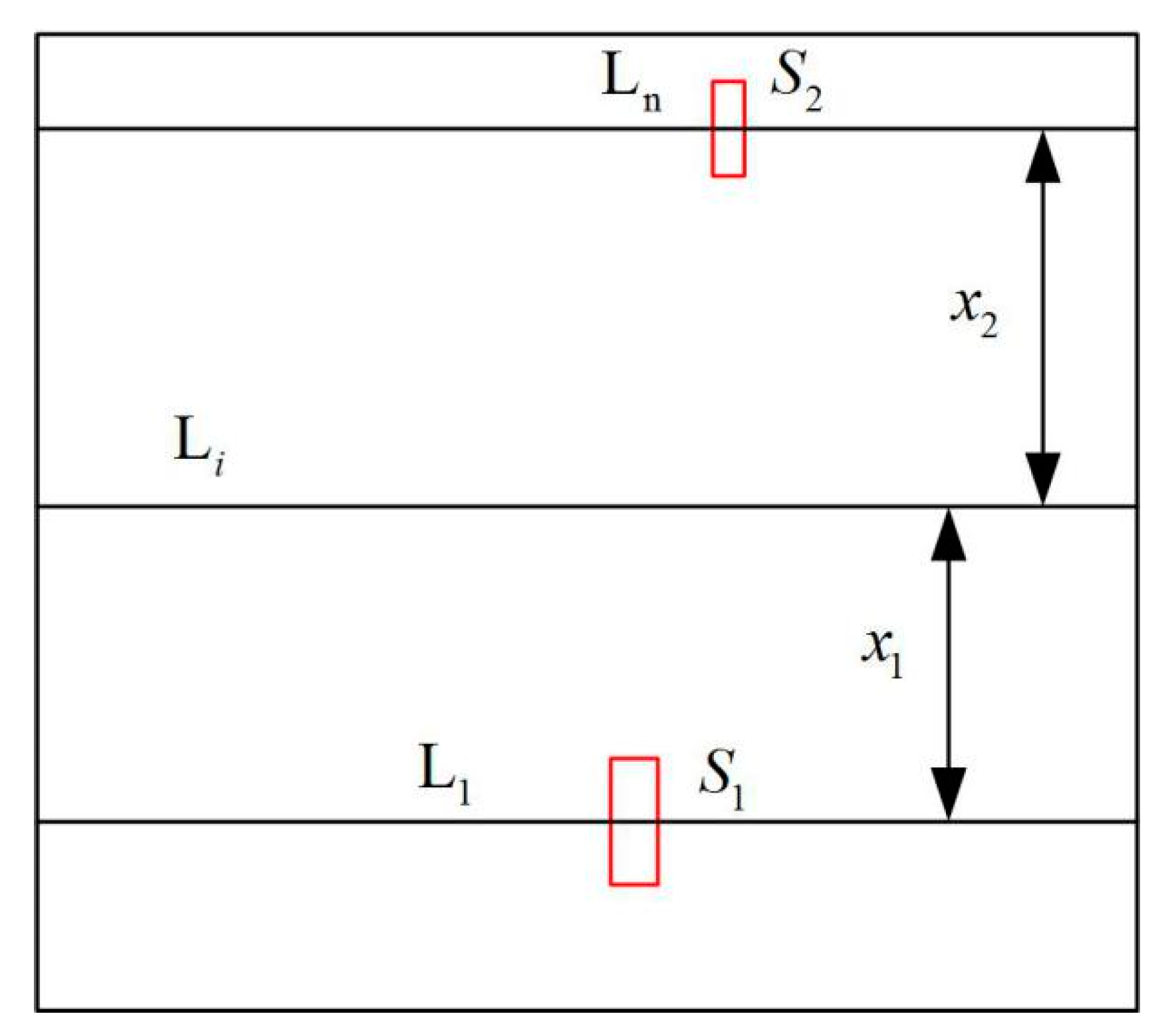
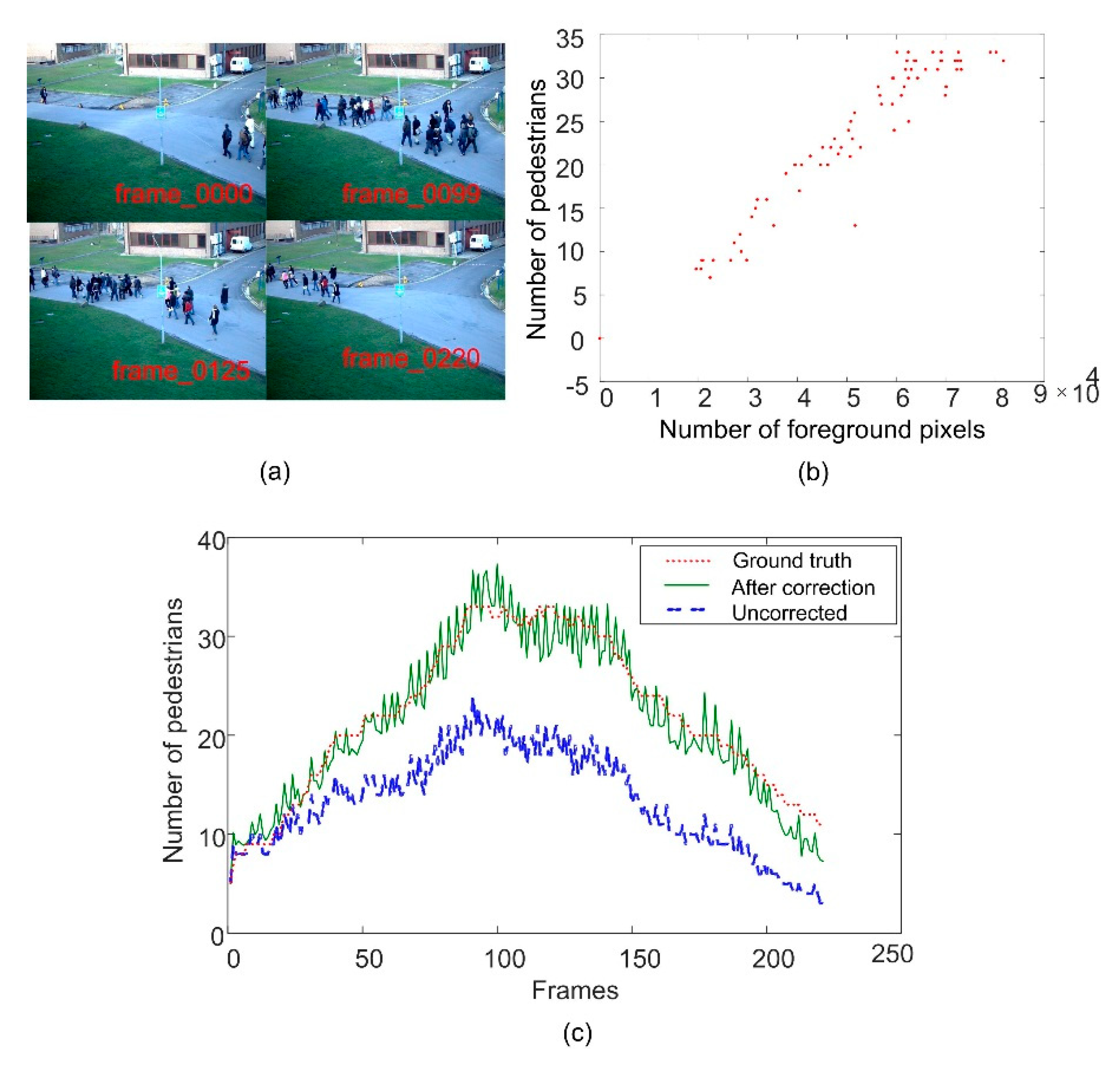
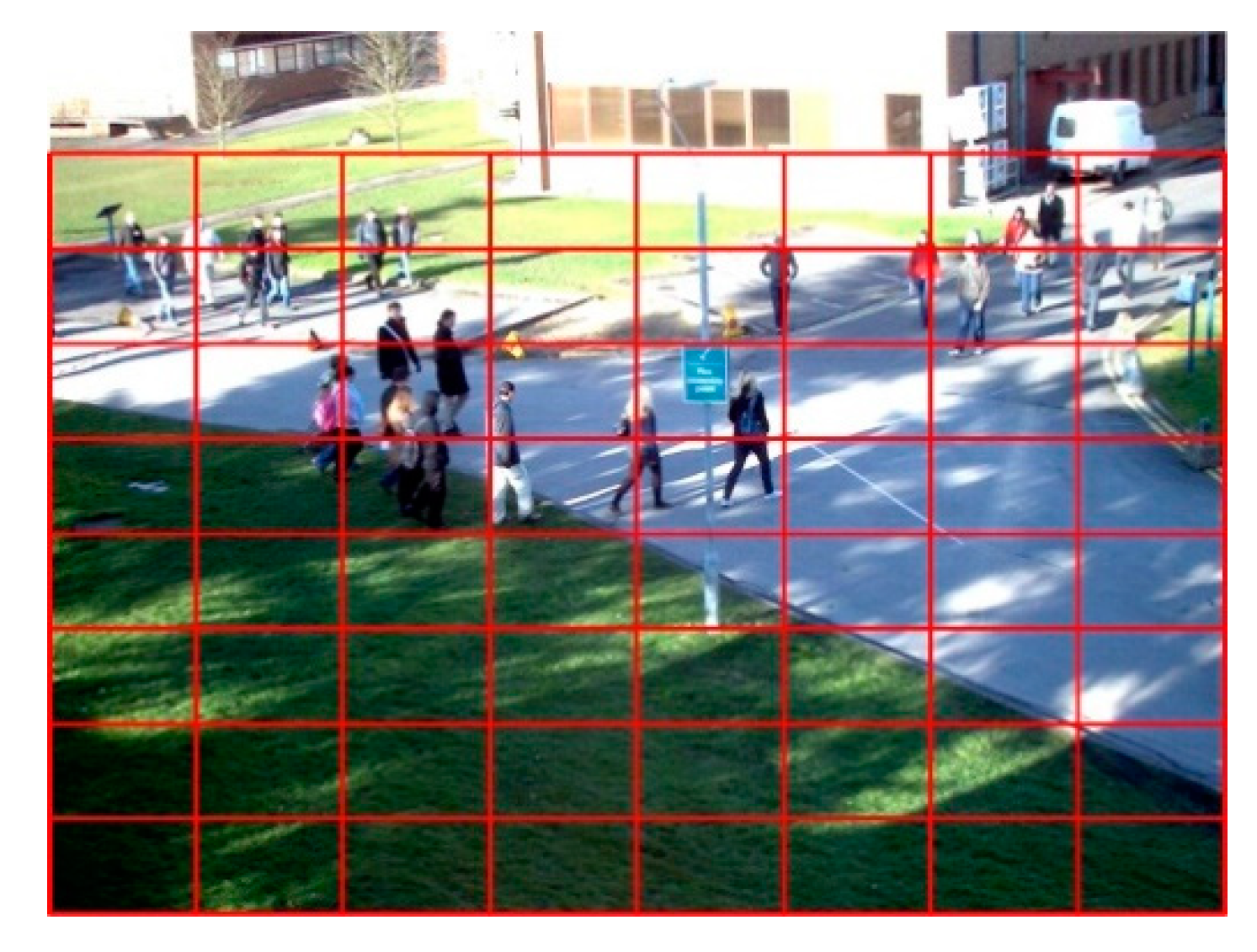

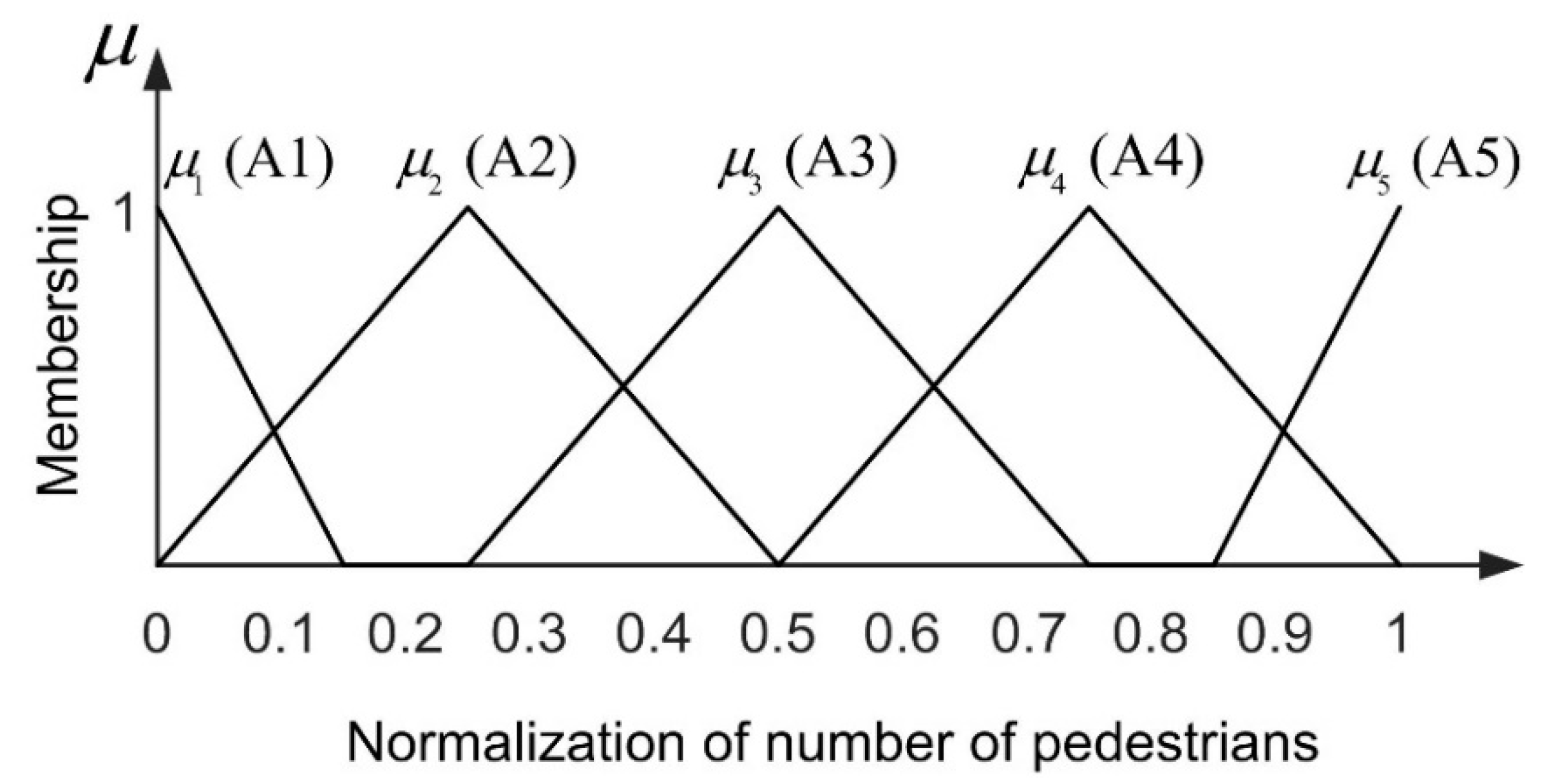

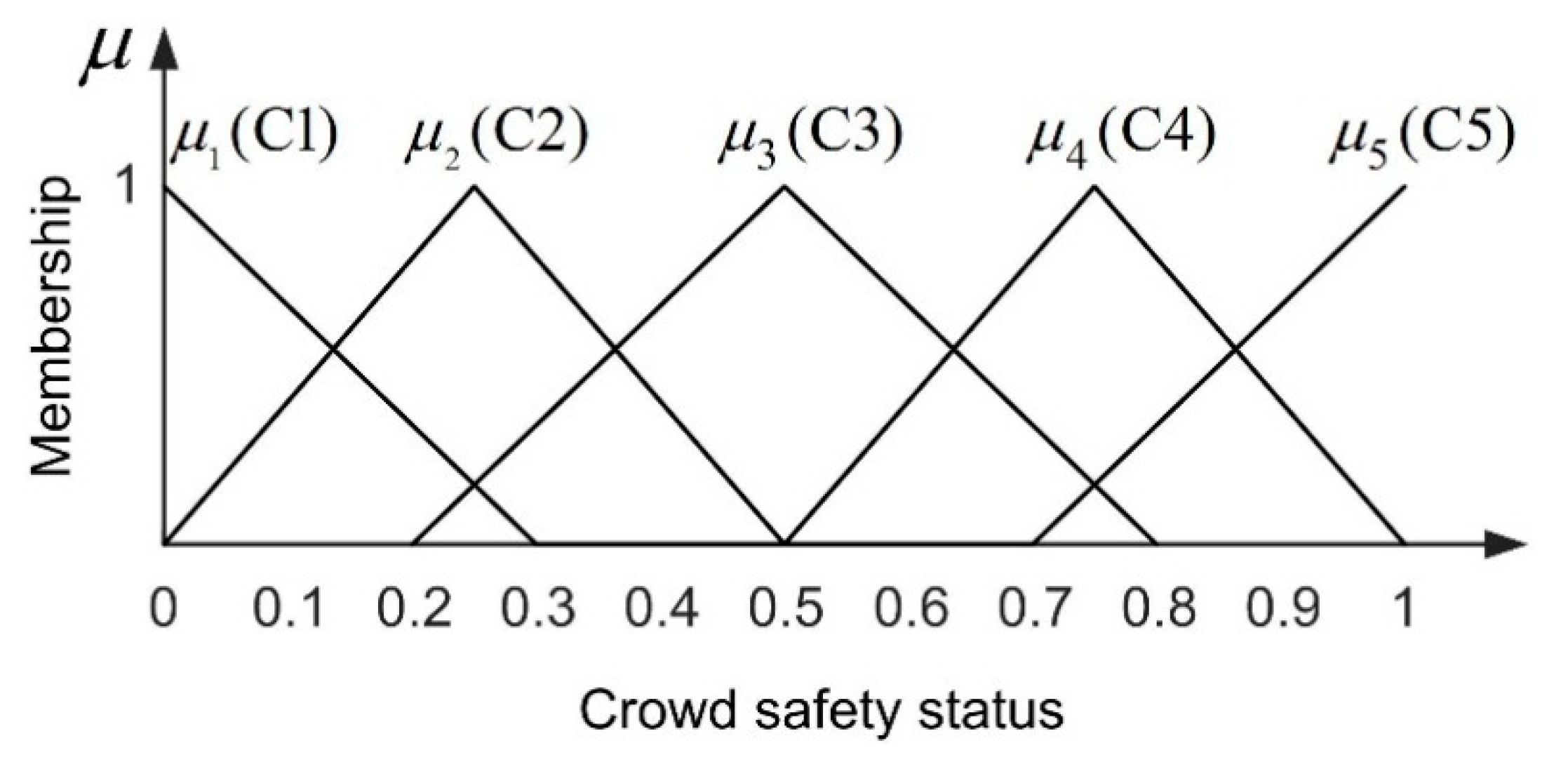


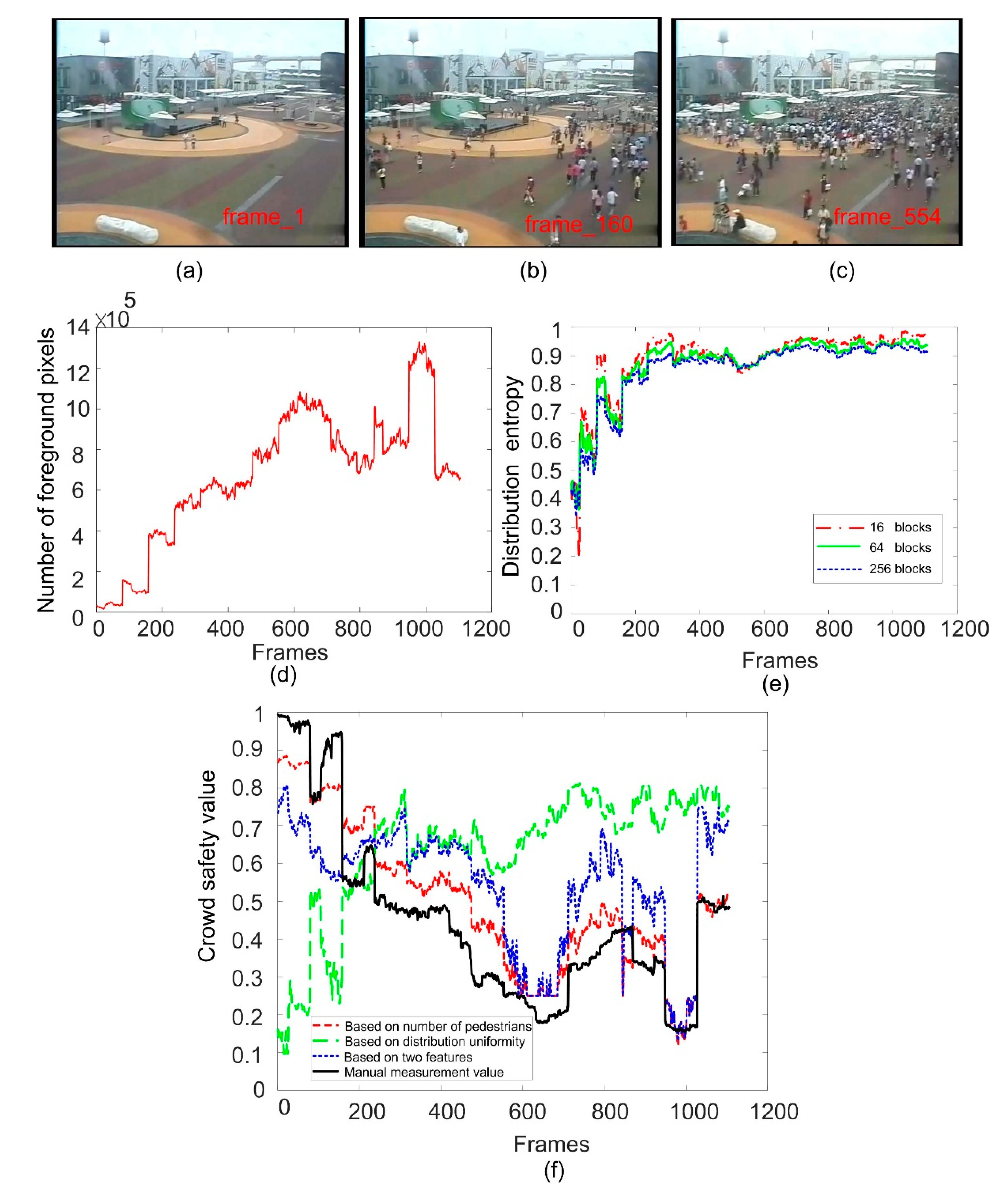
| Variables | Number of Pedestrians | |||||
|---|---|---|---|---|---|---|
| A1 | A2 | A3 | A4 | A5 | ||
| Crowd Distribution Uniformity | B1 | C5 | C2 | C2 | C1 | C1 |
| B2 | C5 | C3 | C2 | C1 | C1 | |
| B3 | C5 | C4 | C3 | C2 | C1 | |
| B4 | C5 | C4 | C4 | C2 | C1 | |
| B5 | C5 | C4 | C4 | C2 | C1 | |
| Video Sequences | Parameters | Values |
|---|---|---|
| View_001 | Frame number | 344 |
| Image size | 768 × 576 | |
| 100736 | Frame number | 1106 |
| Image size | 720 × 352 | |
| Unity 3D | Frame number | 86 |
| Image size | 850 × 648 |
| Video Sequences | Parameters | Number of Pedestrians | Distribution Uniformity | Combination of Two Features |
|---|---|---|---|---|
| Unity | MAE | 0.1157 | 0.2890 | 0.1066 |
| MRE | 0.2112 | 0.4655 | 0.1480 | |
| View_001 | MAE | 0.2166 | 0.3124 | 0.1005 |
| MRE | 0.4750 | 0.5429 | 0.1568 | |
| 100736 | MAE | 0.0815 | 0.3751 | 0.1688 |
| MRE | 0.2143 | 1.1314 | 0.4141 |
© 2020 by the authors. Licensee MDPI, Basel, Switzerland. This article is an open access article distributed under the terms and conditions of the Creative Commons Attribution (CC BY) license (http://creativecommons.org/licenses/by/4.0/).
Share and Cite
Zhang, X.; Yu, Q.; Wang, Y. Fuzzy Evaluation of Crowd Safety Based on Pedestrians’ Number and Distribution Entropy. Entropy 2020, 22, 832. https://doi.org/10.3390/e22080832
Zhang X, Yu Q, Wang Y. Fuzzy Evaluation of Crowd Safety Based on Pedestrians’ Number and Distribution Entropy. Entropy. 2020; 22(8):832. https://doi.org/10.3390/e22080832
Chicago/Turabian StyleZhang, Xuguang, Qinan Yu, and Yuxi Wang. 2020. "Fuzzy Evaluation of Crowd Safety Based on Pedestrians’ Number and Distribution Entropy" Entropy 22, no. 8: 832. https://doi.org/10.3390/e22080832
APA StyleZhang, X., Yu, Q., & Wang, Y. (2020). Fuzzy Evaluation of Crowd Safety Based on Pedestrians’ Number and Distribution Entropy. Entropy, 22(8), 832. https://doi.org/10.3390/e22080832





